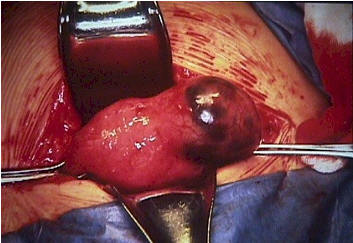|
Miscarriage (Spontaneous Abortion)
Miscarriage is the layman's term for spontaneous abortion, an
unexpected 1st trimester pregnancy loss.
Since the term "spontaneous abortion" may be misunderstood by
laymen, the word "miscarriage" is sometimes substituted.
|
 Abortion
Loss of a pregnancy during the first 20 weeks of pregnancy, at a
time that the fetus cannot survive. Such a loss may be involuntary (a
"spontaneous" abortion), or it may be voluntary ("induced" or
"elective" abortion).
Abortions are further categorized according to their degree of
completion. These categories include:
-
Threatened
-
Inevitable
-
Incomplete
-
Complete
-
Septic
Such losses are common, occurring in about one out of every 6
pregnancies.
For the most part, these losses are unpredictable and
unpreventable. About 2/3 are caused by chromosome abnormalities
incompatible with life. About 30% are caused by placental
malformations and are similarly not treatable. The remaining
miscarriages are caused by miscellaneous factors but are not usually
associated with:
-
Minor trauma
-
Intercourse
-
Medication
-
Too much activity
Following a miscarriage, the chance of having another miscarriage
with the next pregnancy is about 1 in 6. Following two miscarriages in
a row, the odds of having a miscarriage with the next pregnancy is
still about 1 in 6. After three consecutive miscarriages, the risk of
having a fourth is greater than 1 in 6, but not very much greater. Threatened Abortion
A threatened abortion means the woman has
experienced symptoms of bleeding or cramping.
At least one-third of all pregnant women
will experience these symptoms. Half will go on to abort
spontaneously. The other half will see the bleeding and cramping
disappear and the remainder of the pregnancy will be normal. These
women who go on to deliver their babies at full term can be reassured
that the bleeding in the first trimester will have no effect on the
baby and that you expect a full-term, normal, healthy baby.
Treatment of threatened abortion should be
individualized. Many obstetricians recommend bedrest in some form for
women with a threatened abortion. There is no scientific evidence that
such treatment changes the outcome of the pregnancy in any way,
although some women may feel better if they are at rest. Other
obstetricians feel that being up and active is psychologically better
for the patient and will not change the risk of later miscarriage.
Among these active women, strenuous physical activity is usually
restricted, as is intercourse.
In an operational setting, bedrest may prove
very useful. While you are not changing the outcome of the pregnancy
(abnormal chromosomes will remain abnormal despite increased maternal
rest), you may effectively postpone the miscarriage until a safer
time. (days to possibly a week or two)
Continue
to the PowerPoint Lecture...
From:
Operational Obstetrics & Gynecology
2nd Edition
NAVMEDPUB 6300-2C
Bureau of Medicine and Surgery
Department of the Navy |


